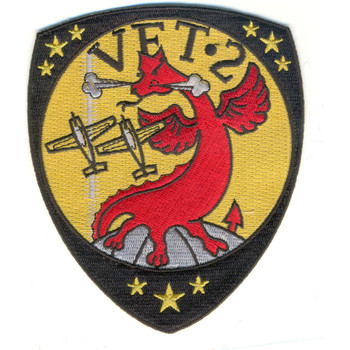Description
Domain of the Golden Dragon Patch 4.5" x 4.5" Embroidered Patch with Iron-On Backing
Superior Materials: Made with premium polyester thread and durable twill fabric, ensuring long-lasting color and strength.
Advanced Embroidery Technology: Crafted using the most advanced embroidery machinery, guaranteeing intricate detail, sharp lines, and consistent quality every time.
Easy Iron-On Application: Features a heat-activated adhesive backing for quick, no-sew attachment. Simply position, iron, and press for a secure bond.
Versatile Use: Perfect for personalizing jackets, backpacks, uniforms, or any fabric surface that needs a touch of personality.
Durable and Washable: Designed to withstand everyday wear and occasional washing without fading or fraying.
Formations & Origins
The "Domain of the Golden Dragon" patch is a naval tradition, specifically awarded to U.S. Navy personnel who cross the 180th meridian — the International Date Line. This crossing is often referred to as “crossing the line,” and the Golden Dragon patch is a ceremonial insignia marking this rite of passage, signifying that the sailor has entered the “Domain of the Golden Dragon,” a mythical territory in the Pacific. The tradition dates back to the early days of naval exploration in the Pacific during the 19th century, when sailors who crossed the equator or the International Date Line were subjected to a colorful, sometimes irreverent, initiation ceremony. The patch itself is a symbol of this tradition and is often worn proudly as a marker of having participated in this naval rite.
Notable Commanders
There are no specific commanders associated with the Golden Dragon tradition, but naval officers and sailors who participated in long Pacific voyages or who served aboard ships that routinely crossed the equator and the International Date Line carried this tradition forward. One notable figure, though, was Admiral Chester W. Nimitz, who oversaw extensive operations in the Pacific Theater during World War II. While he himself may not have been ceremonially initiated, the U.S. Navy’s regular crossings of the International Date Line during the war meant many of his sailors participated in the Golden Dragon ceremony, forging a link between the history of naval exploration and the operational needs of wartime.
Major Campaigns/Operations
The Golden Dragon tradition is most closely tied to the Navy's long history of Pacific operations, especially during World War II, the Cold War, and into the modern era. The crossing of the International Date Line became a frequent occurrence for Navy ships stationed in the Pacific Ocean. Notably, the naval campaigns during World War II, such as the Battle of the Pacific, where fleets engaged in extensive island-hopping campaigns, saw many sailors and ships cross the line multiple times. The Navy’s strategic presence in the Pacific, particularly during the Cold War and into modern-day tensions with China and North Korea, has ensured the continuation of this tradition, with newer vessels crossing the Date Line during deployments.
Specialized Role/Equipment
The Golden Dragon patch isn’t tied to a specific piece of military equipment or role; rather, it is an honor given to sailors who partake in the ceremonial aspect of naval life. However, the ships involved in these crossings are often those involved in long-haul deployments — aircraft carriers, destroyers, and submarines — all of which play critical roles in power projection, diplomacy, and combat readiness in the Pacific. For submarines, crossing the Date Line underwater, out of sight of the world above, adds a mystique and sense of quiet heroism to the ceremony.
Acts of Heroism
While crossing the Date Line is primarily a ceremonial event, the sailors who participate in these traditions often face perilous challenges in the vast, unpredictable Pacific. From dangerous storms and high-seas battles to the rigorous conditions of long deployments, sailors on these missions often demonstrate extraordinary resilience. The Golden Dragon patch itself, a lighthearted badge of honor, symbolizes much more than simply a line crossed — it reflects the courage and perseverance required to survive in the relentless expanse of the Pacific, particularly when these sailors are often hundreds of miles from land and cut off from the comforts of civilization.
Legacy & Notable Achievements
The Golden Dragon patch, while primarily a naval tradition, has become a symbol of the broader U.S. Navy’s strategic and historical presence in the Pacific. It embodies not just a rite of passage, but the enduring spirit of exploration and commitment that has marked the Navy’s long history in the region. In more recent years, the patch has maintained its place as a fun, unifying tradition among sailors, with newer generations continuing to cross the International Date Line in the service of freedom and peace. While it may not be as serious as some of the Navy’s other patches or medals, the Golden Dragon patch remains an enduring symbol of naval life in the Pacific — a reminder that no matter how far one travels, the sea will always have its traditions. A sailor who wears this patch carries with them a piece of that vast, history-laden ocean.
4 Reviews
-
Golden dragon patch
Colors and detail in the patch is very good
-
The Golden Dragon Patch
Because I have crossed the equator AND the International dateline twice while serving on the USS Hancock via VF-211, I have earned both the Golden Dragon and the Golden Shellback awards/patches to display/wear. And, might I say as well...proudly I will wear them !
-
Perfect
Excellent craftsmanship and professionally created


















